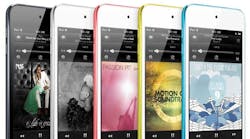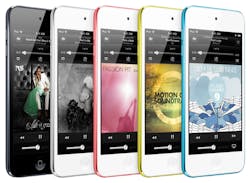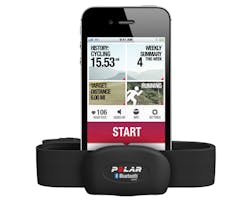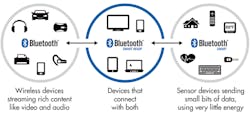This file type includes high resolution graphics and schematics when applicable.
There is an explosion underway of wearable sports and fitness sensor devices. You see them everywhere. Runners with Polar heart-rate sensors keep track of a target heart rate. Cyclists with sensors on their bike wheels measure speed and cadence. Even the executive down the hall wears his FitBit on his pocket to ensure his motion is monitored in real time. This proliferation is part of the Internet of Things (IoT), and Bluetooth technology is making it happen.
Related Articles
- Low-Energy Bluetooth Smart Modules Suit Medical Devices
- Bluetooth And Wi-Fi Rule The Airwaves
- Bluetooth Low Energy Finally Earns Some Respect
The globally recognized wireless standard makes it possible for everyday things to go wireless and connect to each other, to applications on Bluetooth Smart Ready hub devices like smart phones, laptops, and tablets, and, ultimately, to the cloud. According to ABI Research, the sports and fitness arena represents the bulk of this market—and is expected to lead it due to its ubiquity, performance, and low cost. Bluetooth Smart sensors equipped with the low-energy feature of Bluetooth plus the ubiquity of Bluetooth Smart Ready hub devices, a rich base of suppliers, and low-cost chips combine to create a powerful trifecta for designing your sports or fitness device with Bluetooth.
According to IMS Research, more than 60 million sports, fitness, and health monitoring devices equipped with Bluetooth will ship between 2010 and 2015. Industry leaders like Adidas, HIOD Sports, Nike, Polar, and Wahoo Fitness are utilizing Bluetooth to connect everything for their sports and fitness monitoring solutions.
“Bluetooth technology is changing the way manufacturers look at connectivity and the potential of their products,” said Mark Powell, executive director, Bluetooth SIG. “Increasingly, Bluetooth is being used to allow billions of diverse products from countless manufacturers to speak the same language. This results in unmatched convenience for the consumer, flexibility for the product manufacturers, and access for application developers.”
Bluetooth Smart And Smart Ready
The latest Bluetooth specification’s ultra-low-power consumption presents a massive opportunity for companies to bring everyday products such as heart-rate monitors, toothbrushes, and running shoes into the connected world. Known as Bluetooth Smart, these devices are usually sensors sending information to an application running on a “hub” device like a smart phone, tablet, or PC.
These hubs, which receive information from power-efficient Bluetooth Smart products, are called Bluetooth Smart Ready. The unique capability of Smart Ready devices—the dual-mode Bluetooth radio (basic rate/enhanced data rate + low energy radio)—allows communication with traditional Bluetooth devices like headsets and wireless speakers, plus the newest generation of Bluetooth Smart devices.
Smart Ready devices also can be updated with new Bluetooth profiles after shipping from the factory. This allows them to connect to new Bluetooth Smart products and their associated apps as they come to market. Think of Smart Ready products as the center of the connected world. Bluetooth Smart devices securely feed data to apps on the Smart Ready hub, which in turn acts as a gateway and sends data to the cloud.
All new Apple iOS (since the iPhone 4s) and OS X (since Q4 2011) devices and new Windows 8 tablets and PCs are Bluetooth Smart Ready. So are BlackBerry 10 devices. In July 2013, Google announced that Android 4.3 natively supports Bluetooth Smart Ready as well. Traditional Bluetooth and new Bluetooth Smart devices now can connect to hundreds of millions of phones, tablets, and PCs without special dongles or extra hardware.
Why Bluetooth Smart
It’s important to understand that the power consumption of a dual-mode chip in a Bluetooth Smart Ready device when operating in basic rate/enhanced data rate (BR/EDR) mode is no different from previous versions of the technology. The device’s low-energy capability saves some power, but the chips aren’t ultra-low-power devices. The chip’s functionality, size, cost, and compliance are close to the previous version.
In contrast, Bluetooth Smart devices are ultra-power-efficient. They employ a configurable connection interval that can be set from a few milliseconds to several seconds depending on the application. In addition, because it features a very rapid connection, Bluetooth Smart normally can be in a “not connected” state (saving power) where the two ends of a link are aware of each other, but only link up when absolutely necessary and then for as short a time as possible.
Bluetooth Smart chips operate for long periods (months or even years) from a coin cell battery such as a 3-V, 220-mAh CR2032. These devices support very low-duty-cycle operation. If you’re looking for an interoperable 2.4-GHz radio technology for fully asynchronous transmission from a device sending low volumes of data (i.e., a few bytes) infrequently (for example, a few times per second to once every minute or more seldom), then Bluetooth Smart is the best choice. Compact wireless sensors such as heart-rate monitors, cycle speed, and distance pods—in other words, many of the devices in the sports and fitness monitoring and tracking arena—are typical examples.
Bluetooth Smart products use some interesting tricks to reduce power consumption. The technology minimizes time on air by employing only three “advertising” channels to search for other devices or promote its own presence to devices that might be looking to make a connection. In comparison, conventional Bluetooth technology uses 32 channels. Bluetooth Smart devices need to switch “on” for just 0.6 to 1.2 ms to scan for other devices, while conventional Bluetooth technology requires up to 22.5 ms to scan 32 channels.
Consequently, Bluetooth Smart devices use 10 to 20 times less power to locate other radios. Once connected, the radio switches to one of its 37 data channels and then hops in a pseudorandom pattern using Bluetooth adaptive frequency hopping (AFH) technology. AFH ensures data travelling via Bluetooth securely gets from point A to point B even in chatty networking environments.
Also, Bluetooth Smart’s raw data bandwidth of 1 Mbit/s allows information to be sent rapidly so the radio can quickly return to an ultra-low-power sleep state. A connection (i.e., scan for other devices, link, send data, authenticate, and terminate) takes just 3 ms. With conventional Bluetooth technology, a similar connection cycle is measured in hundreds of milliseconds. More time on air requires more energy from the battery.
Bluetooth Smart also keeps a lid on peak power in two other ways: by employing more “relaxed” RF parameters than its big brother, and by sending very short packets. Shorter packets further minimize the time on air and keep the silicon cooler, eliminating the need for power-consuming recalibration and closed-loop architecture.
Profiles For The Sports & Fitness Market
Product designers know the chip is just the first choice to make. Profiles are the special sauce of Bluetooth technology. In August 2012, the Bluetooth SIG introduced key profiles for the sports and fitness market. The new profiles, Running Speed and Cadence (S&C) and Cycling Speed and Cadence, extended capabilities for real-time running and cycling data monitoring. They also added critical functionality previously reserved for proprietary solutions.
Companies can now quickly implement Bluetooth Smart sensors in sports devices to instantaneously transmit data such as running cadence, stride length, total distance, or cycling speed, distance, and pedal cadence to Bluetooth Smart Ready devices like smart phones (Fig. 2).
Historically, sports and fitness sensors capable of tracking speed and cadence relied on proprietary technology, severely limiting the potential number of devices they could connect to. In contrast, the Running S&C and Cycling S&C profiles unlocked these sensors, allowing companies to build products that connect with tens of millions of Bluetooth Smart Ready devices already on the market and hundreds of millions on the way in the coming quarters.
More sports and fitness profiles are on the way with leading manufacturers like Polar and Intel, among many others, collaborating on standard profiles. Any company can join the Bluetooth SIG as an associate member and drive the creation of more profiles through working groups.
Bluetooth Branding
Additional design choices made possible by Bluetooth 4.0 provide great opportunity for the market, but change the landscape of compatibility between Bluetooth devices. To aid consumers in understanding the compatibility among devices, the Bluetooth SIG created Bluetooth Smart marks (Fig. 3).
While the logos provide consumer guidance on device compatibility, earning that logo really makes the news. Bluetooth Smart Ready devices—hubs like phones, PCs, tablets, and TVs—must include the Bluetooth dual-mode radio described above and provide a means for consumers to update the software on each device.
This is less complicated than it may at first sound. In many cases, the device OEM includes the chip while the operating system powering the device natively takes care of enabling updateable profiles. Typically, the software update is transparent to users because it is implemented when they download the application associated with their new Bluetooth Smart device.
For instance, a consumer purchases a new-heart rate monitor and downloads the supporting app to a smart phone. The Bluetooth heart-rate data profile is also installed on the smart phone in the background, and the two devices work seamlessly together even though the heart-rate profile wasn’t on the phone prior to installing the app.
This ability to update profiles on Smart Ready hubs is a game-changer for OEMs working with Bluetooth. It ensures that as new low-energy Bluetooth Smart sensors come to market, the Smart Ready hub devices consumers already own can be updated to be compatible, which frees OEMs to build products based on new profiles and still reach the huge install base of Smart Ready hubs.
Requirements For Qualification
A Bluetooth Smart brand qualified product must incorporate Bluetooth Core Specification Version 4.0 (or higher) with GATT-based (Generic Attribute) architecture, feature a single-mode radio, and use the GATT-based architecture to enable particular device functionality.
A Bluetooth Smart Ready qualified product similarly must incorporate Bluetooth Core Specification Version 4.0 (or higher) with GATT-based architecture; feature a dual-mode radio (BR/EDR + Bluetooth low energy) where both radio modes may be activated, individually or simultaneously; and provide a means by which the end user can update functionality for a Bluetooth Smart device on the Bluetooth Smart Ready device. Manufacturers should also provide a way for third parties to create and distribute applications that receive data from Bluetooth Smart devices.
The SIG refers to hub devices using Bluetooth 4.0 as “Bluetooth Smart Ready” because they’re “ready” to connect to the entire universe of Bluetooth devices in the market and because the updateable profiles can be made “ready” for new Bluetooth Smart devices as they are introduced.
Bluetooth Smart Ready products in the market include the iPhone 5 and 4S, the new iPad, the Motorola RAZR, the Samsung Galaxy, and all new hardware running Windows 8. Bluetooth Smart devices include the Polar H7 heart-rate monitor, the Wahoo Fitness Blue HC Cycling monitor, and the Casio G-Shock GB-6900 smart watch. All of the devices currently on the market can be found at www.bluetooth.com/Pages/Bluetooth-Smart-Devices-List.aspx.
Putting It All Together
Beyond the sports and fitness market, the SIG sees this transformation playing out in other verticals like healthcare, the smart home, and industrial automation. Connected “things” are all part of the bigger movement toward the IoT, and Bluetooth will be an integral wireless technology to connect billions of power-sensitive sensors to Web services.
Bluetooth technology is multiplying at an amazing rate. ABI Research expects 2.5 billion Bluetooth enabled products to be shipped by the end of 2013, growing to approximately 5 billion per year by 2017. Bluetooth has already shipped More than 9 billion Bluetooth products have been shipped since the inception of the technology, and this massive network of connected devices will triple by 2017. The new use cases made possible by Bluetooth Smart are accelerating this growth.
Understanding the market opportunity, the benefits, and the flexibility of Bluetooth and the clear path forward for the branding of Bluetooth devices should make the choice an obvious one for product designers of sports and fitness devices. Bluetooth technology makes perfect sense.






